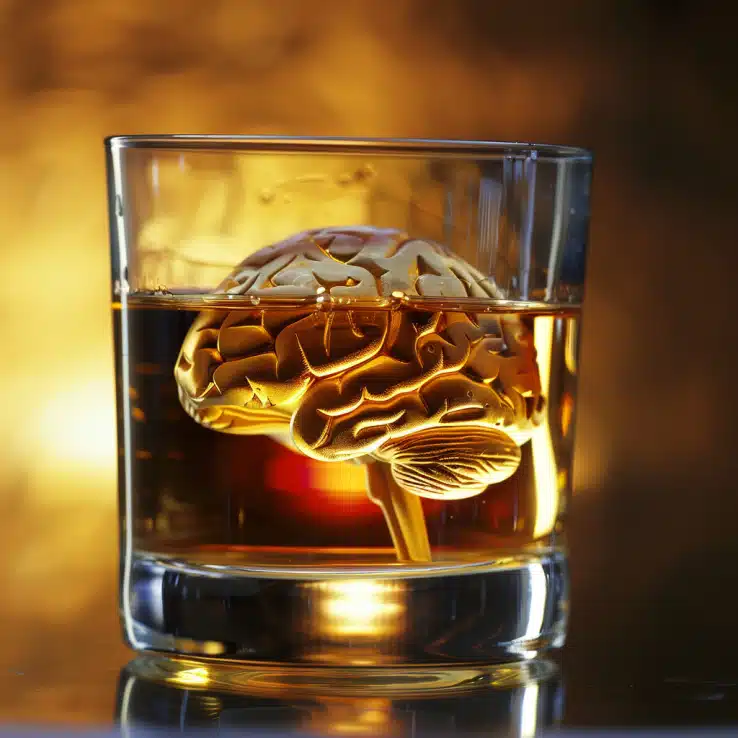Alcohol use disorder (AUD) is associated with impairments in dopamine (DA) neurotransmission, with significant differences in DA release, receptor availability, and transporter density observed across different levels of alcohol consumption and stages of AUD.
Highlights:
- Acute Alcohol Effects: Social drinkers exhibit a dopamine release in the striatum, particularly the ventral striatum, after acute alcohol consumption, while individuals with alcohol use disorder (AUD) show blunted dopamine release.
- Dopamine Receptor Availability: Reduced dopamine D2/D3 receptor availability is commonly observed in individuals with alcohol use disorder (AUD), particularly in the striatum and sometimes in cortical regions.
- Dopamine Transporter Density: Most studies indicate reduced dopamine transporter (DAT) density in individuals with AUD, though findings are mixed and recovery during abstinence remains unclear.
- Dopamine Synthesis Capacity: No consistent differences in dopamine synthesis capacity between AUD patients and healthy controls, though withdrawal symptoms have been linked to reduced synthesis capacity.
Source: Neuropsychobiology (2023)
Major Findings: Alcohol Use Disorder (AUD) vs. Dopamine (DA) Neurotransmission (2023)
Spitta et al. discussed the impact of alcohol on dopamine within the brain based on neuroimaging studies using PET & SPECT scans.
1. Acute Alcohol Effects on Dopamine Release
Acute alcohol consumption triggers dopamine release in social drinkers but this effect is diminished in individuals with alcohol use disorder (AUD).
- Social Drinkers: When people without AUD consume alcohol, there is a notable release of dopamine in the brain’s reward regions, especially the ventral striatum. This release contributes to the pleasurable effects of alcohol, encouraging further consumption.
- Individuals with AUD: In contrast, those with AUD show a reduced or blunted dopamine response. This suggests that chronic alcohol use may lead to changes in the brain that dampen its reward system, potentially driving individuals to consume more alcohol to achieve the same effects.
2. Dopamine D2/D3 Receptor Availability
Dopamine D2 and D3 receptors are less available in the brains of individuals with AUD, particularly in the striatum.
- Receptor Availability: Dopamine receptors are crucial for transmitting signals in the brain. In people with AUD, these receptors, especially D2 and D3 types, are less available. This reduction is most noticeable in the striatum, a brain region involved in reward and habit formation.
- Impact: Lower receptor availability might contribute to the diminished pleasure from everyday activities and substances, making individuals more reliant on alcohol to feel good. This change could either be a result of long-term alcohol use or a pre-existing condition that makes individuals more susceptible to AUD.
3. Dopamine Transporter (DAT) Density
The density of dopamine transporters (DAT) is generally reduced in individuals with AUD, although some studies show mixed results.
- Function of DAT: Dopamine transporters help clear dopamine from the synaptic cleft (the space between neurons), thereby regulating dopamine levels.
- Reduced Density: Most studies find that people with AUD have fewer dopamine transporters, especially in the striatum. This could mean that their brains are less efficient at regulating dopamine, leading to altered dopamine signaling.
- Recovery During Abstinence: There is some evidence suggesting that DAT density might recover with prolonged abstinence from alcohol, but findings are not consistent.
4. Dopamine Synthesis Capacity
There is no consistent evidence that dopamine synthesis capacity is significantly different between individuals with AUD and healthy controls.
- Synthesis Capacity: Dopamine synthesis refers to the brain’s ability to produce dopamine. Most studies reviewed did not find a significant difference in this capacity between those with AUD and those without.
- Withdrawal Symptoms: Some studies suggest that dopamine synthesis might be lower in individuals experiencing withdrawal symptoms, indicating that withdrawal could temporarily affect the brain’s ability to produce dopamine.
5. Consistency of Findings in Challenge Studies
Studies involving alcohol or psychostimulant challenges are more consistent in their findings compared to other study designs.
- Challenge Studies: These studies involve administering alcohol or stimulant drugs and observing the resulting dopamine release. They tend to produce more consistent results, showing clear impairments in dopamine release in individuals with AUD.
- Less Prone to Confounders: Such studies are generally less affected by confounding factors (variables that can distort the results), making their findings more reliable in demonstrating the differences in dopamine neurotransmission between those with and without AUD.
Study Details: Alcohol Intake vs. Dopamine in the Brain (2023)

The review from Spitta et al. summarized and analyzed findings from single-photon emission tomography (SPECT) and positron emission tomography (PET) studies on dopamine (DA) neurotransmission in relation to different levels of alcohol consumption and the development of alcohol use disorder (AUD).
The review focused on understanding the changes in DA receptor availability, DA transporter density, and DA synthesis capacity across various stages of alcohol consumption, from social drinking to severe AUD.
Sample
- Total Participants: 1,201
- Studies Reviewed: 35 PET and 10 SPECT studies
- Participant Groups: Social drinkers, individuals at high risk, and patients with severe AUD
Methods
- Data Collection: SPECT and PET imaging studies were reviewed. The studies focused on acute alcohol consumption, psychostimulant administration, and DA system markers (receptor availability, transporter density, and synthesis capacity).
- PET: Used to measure DA receptor and transporter availability and DA synthesis capacity.
- SPECT: Used for measuring DA transporter density.
- Analysis: Comparison of DA system markers between social drinkers, high-risk individuals, and patients with AUD. Examination of the effects of acute alcohol administration and psychostimulant challenges on DA release. Consideration of potential confounding factors such as age, smoking status, and sex/gender differences.
Limitations
- Sample Size: Many studies had small sample sizes, limiting the generalizability of findings.
- Heterogeneity: Variability in study design, participant selection, and imaging methods made it difficult to directly compare results across studies.
- Confounding Factors: Differences in age, smoking status, and sex/gender were not always adequately controlled, potentially affecting the outcomes.
- Duration of Abstinence: Variability in the duration of abstinence among participants with AUD complicates the interpretation of DA system recovery.
- Tracer Selection: Different tracers used in PET and SPECT studies might lead to inconsistencies in measuring DA markers.
- Dimensional Approach: Lack of studies using a dimensional approach to AUD as outlined in the DSM-5, limiting the understanding of continuous changes in DA neurotransmission.
Conclusion: Dopamine Alterations with Alcohol Consumption
This review highlights significant alterations in the dopamine (DA) neurotransmitter system across different levels of alcohol consumption and stages of alcohol use disorder (AUD).
Acute alcohol consumption leads to DA release in social drinkers but results in a blunted DA response in individuals with AUD, indicating impaired reward processing.
Chronic alcohol use is associated with reduced DA D2/D3 receptor availability and decreased dopamine transporter (DAT) density, suggesting neuroadaptive changes aimed at balancing prolonged high DA levels.
Findings on DA synthesis capacity remain mixed, but withdrawal symptoms may temporarily impair dopamine production.
Challenge studies using psychostimulants consistently reveal impairments in DA release, emphasizing the robustness of these findings.
Overall, these DA system alterations contribute to the development and persistence of AUD, underscoring the need for long-term, well-controlled studies to further elucidate these mechanisms and inform treatment strategies.
References
- Study: Dopamine and Alcohol: A Review of in vivo PET and SPECT Studies (2023)
- Authors: Gianna Spitta et al.








